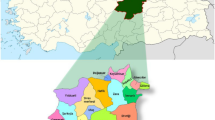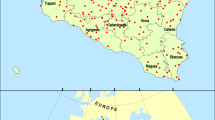Abstract
The culturally valued and scientifically important ethnobotanical knowledge associated with the indigenous community is highly vulnerable due to changes in current socio-economic status. Such knowledge is still in the hands of traditional communities, and the knowledge is transferred from generation to generation as personal memories. Hence, collection, conservation, and utilization of indigenous knowledge are essential globally before disappearing from old generations of local communities. Underutilized food crops are often utilized by under privilege communities in the developing world. The knowledge associated with such species remains with them as personal memories. Lasia spinosa is such neglected edible aroid in Asia with remarkable food and medicinal values. The species is characterized by sharp and pointed spines on rhizome and leaf petiole. Despite its spiny nature, it is popular among some village communities in Asia primarily as a vegetable. This study collected ethnobotanical information on all aspects of L. spinosa across its native range. The authors collected the required ethnobotany information after consultation with key informants from various countries and referring to historical and recent literature. The results consist of information on different names applied, folk classification, food and medicinal uses, and traditional beliefs which can integrate into current knowledge aiming for popularizing L. spinosa as a vegetable among consumers as well as farmers.










Similar content being viewed by others

Data availability
Data collected in this research is available upon reasonable request to the corresponding author.
References
Abebe BA, Teferi SC (2021) Ethnobotanical study of medicinal plants used to treat human and livestock ailments in Hulet Eju Enese Woreda, East Gojjam zone of Amhara region, Ethiopia. Evid Based Complement Altern Med. https://doi.org/10.1155/2021/6668541
Alam SS, Munira S, Habib MA, Sultana SS (2012) Karyotype and RAPD analysis in common and rare forms of Lasia spinosa (L.) Thwaites. Cytologia 77(4):499–505
Aparicio JC, Voeks R, Funch L (2021) Mixtec taxonomy: plant classification, nomenclature, and identification in Oaxaca, Mexico. Ethnobot Res Appl 21:1–13
Ara H (2001) An annotated checklist of Aroids in Bangladesh. Bangladesh J Plant Taxon 8:19–34
Bhattarai KR (2020) Ethnobotanical survey on plants used in Mai Municipality of Ilam district, Eastern Nepal. Banko Janakari 30(2):11–35. https://doi.org/10.3126/banko.v30i2.33476
Das S, Baruah M, Shill D (2014) Evaluation of antidiabetic activity from the stem of Lasia spinosa in dexamethasone induced diabetic albino rats. Res J Pharm Biol Chem Sci 1(1):12–17
Deb D, Dev S, Das AK, Khanam D, Banu H, Shahriar M, Ashraf A, Choudhuri MSK, Basher SAMK (2010) Antinociceptive, anti-inflammatory and anti-diarrheal activities of the hydroalcoholic extract of Lasia spinosa Linn. (Araceae) roots. Lat Am J Pharm 29(8):1269–1276
Fuller RJM (2013) Ethnobotany: major developments of a discipline abroad, reflected in New Zealand. N Z J Bot 51(2):116–138
Goshwami D, Rahman Md, Muhit Md, Islam Md (2013) Antinociceptive, anti-inflammatory and antipyretic activities of methanolic extract of Lasia spinosa leaves. Int J Pharm Pharm Sci 2(1):118–122
GRAIN (2002) Traditional knowledge of biodiversity in Asia Pacific: problems of piracy and protection-part 1. Aust J Herb Med 14(4):180–182
Hore P, Tanti B (2014) Karyomorphological studies of two morphotypes of Lasia spinosa (Lour.) Thwaites avaiable in Assam, India. J Plant Sci 3(8):792–796
Hossain R, Quispe C, Herrera-Bravo J, Islam, M, Sarkar C, Islam MT, Martorell M, Cruz-Martins N, Al-Harrasi A, Al-Rawahi A, Sharifi-Rad J (2021) Lasia spinosa chemical composition and therapeutic potential: a literature-based review. Oxid Med Cell Longev. https://doi.org/10.1155/2021/1602437
Islam MS, Rashid MM, Ahmed AA, Reza AA, Rahman MA, Choudhury TR (2021) The food ingredients of different extracts of Lasia spinosa (L.) Thwaites can turn it into a potential medicinal food. NFS J. 25:56–69. https://doi.org/10.1016/j.nfs.2021.11.002
Islam AR, Hasan MM, Islam MT, Tanaka N (2022) Ethnobotanical study of plants used by the Munda ethnic group living around the Sundarbans, the world’s largest mangrove forest in southwestern Bangladesh. J Ethnopharmacol 285:114853. https://doi.org/10.1016/j.jep.2021.114853
Jayaweera DMA (1981) Medicinal plants (indigenous and exotic) used in Ceylon-part I: Acanthaceae–Burseraceae. The National Science Foundation, Colombo, Sri Lanka, p 135
Kumar M, Mondal P, Borah S, Mahato K (2013) Physicochemical evaluation, preliminary phytochemical investigation, fluorescence and TLC analysis of leaves of the plants Lasia spinosa (Lour.) Thwaites. Int J Pharm Pharm Sci 5(2):306–310
Kumara A, Kumar S, Ramchiary N, Singh P (2021) Role of traditional ethnobotanical knowledge and indigenous communities in achieving sustainable development goals. Sustainability 13:3062. https://doi.org/10.3390/su13063062
Kumari T, Rajapaksha R, Karunarathne L, Pushpakumara G, Bandaranayake P (2017) Morphological characterization of Lasia spinosa (L.) Thw. Screening of indigenous crop genetic resources for future food and nutritional security. Sri Lanka J Food Agric 3(2):29–36
Lakshmi MA, Priya GV, Rao B (2020) Morpho-anatomical feature and phytochemical assessments of Lasia spinosa (L.) Thwaites. Indian J Pharm Sci 82(5):891–901
Li H, Zhu G, Boyce PB, Murata J, Wilbert L, Hetterscheid A, Bogner J, Jacobsen N (2010) Araceae. In: Wu ZY, Raven PH, Hong DY (eds) Flora of China (Acoraceae through Cyperaceae), vol. 23. Science Press, Beijing, pp 16
Mandal FB, Ghosh A (2009) Role of traditional knowledge systems in taxonomy and biodiversity conservation. Wesley J Res 2(1):62–65
Majumdar K, Datta B (2007) A study on ethnomedicinal usage of plants among the folklore herbalists and Tripuri medical practitioners: part-II. Nat Prod Radiance 6(1):66–73
Müller-Böker U (1993) Ethnobotanical studies among the Chitawan Tharus. J Nepal Res Cent 9:17–56
Nguyen MTT, Awale S, Tezuka Y, Le Tran Q, Watanabe H, Kadota S (2004) Xanthine oxidase inhibitory activity of Vietnamese medicinal plants. Biol Pharm Bull 27(9):1414–1421
Pei S, Alan H, Wang Y (2020) Vital roles for ethnobotany in conservation and sustainable development. Plant Divers 42(6):399. https://doi.org/10.1016/j.pld.2020.12.001
Perry LM, Metzger J (1980) Medicinal plants of east and Southeast Asia: attributed properties and uses. Econ Bot 34:361. https://doi.org/10.1007/BF02858311
Pham HH (2000) Cay co Viet Nam: an illustrated flora of Vietnam, vol 3. Tre Publishing House, Ho Chi Minh (In Vietnamese)
Pittie A, Robertson A (1993) Nomenclature of birds of the Indian subcontinent: a review of some changes taking place. Ornithological Society of India, Bangalore, p 106
Rahmatullah M, Mollik MAH, Islam MK, Islam MR, Jahan FI, Khatun Z, Seraj S, Chowdhury MH, Islam F, Miajee ZUM, Jahan R (2010) A survey of medicinal and functional food plants used by the folk medicinal practitioners of three villages in Sreepur Upazilla, Magura district, Bangladesh. Am Eurasian J Sustain Agric 4(3):363–373
Ranil RHG, Bussmann RW (2021) Potential uses of lycophytes and ferns in Sri Lanka: an ethnopteridological perspective. Ethnobot Res Appl 21(36):1–11
Ranil RHG, Pushpakumara DKNG, Bandaranayake PCG, Ariyaratne WMTP, Wijesundara DDA, Chamara RMSR, Eeswara JP (2019) Lasia spinosa (L.) Thw A high potential underutilized Aroid in Asia: a step toward utilizing neglected crop genetic resources for food and nutritional security. In: Perera SACN, Mohotti AJ (eds) Landscaping agroecosystems: a way forward for natural resource utilization. Institute of Biology, Colombo, pp 119–142
Ranil RHG, Chamara RMSR, Dissanayaka DMSB, Eeswara JP, Pushpakumara DKNG, Wijesuriya G, Jayasekara IGRI (2021) Potential of spineless Lasia spinosa as a neglected indigenous vegetable. Int J Veg Sci 28(2):1–10. https://doi.org/10.1080/19315260.2021.1925384
Sharma K, Saud DS, Bhattarai KR, Amrit KC, Dhakal S, Khadka MK (2020) Wetland plants and their ethnobotanical uses in Raja-Rani Tal, Letang, Morang, Nepal. J Plant Res 18(1):135–142
Shefana AG, Ekanayake S (2009) Some nutritional aspects of Lasia spinosa (kohila). Vidyodaya J Sci 14:59–61
Shen YN, Xiao D, Hu XX, Chen HY, Lin YF, Qing Z, Chen BS, Wen RH (2020) First report of leaf spot on Lasia spinosa caused by Fusarium fujikuroi in China. Plant Dis 104(9):2525–2525
Sultana S, Rahman RB, Alam SS (2006) Karyotype analysis in three morphological forms of Lasia spinosa (L.) Thwaites (Araceae). Cytologia 71(4):359–364
Temjenmongla T, Yadav AK (2005) Anticestodal efficacy of folklore medicinal plants of Naga tribes in North-east India. Afr J Tradit Complement Altern Med 2(2):129–133. https://doi.org/10.4314/ajtcam.v2i2.31111
Teron R (2019) Ethnobotanical study of dietary use and culinary knowledge of Aroids (family Araceae) in Karbi Anglong district. Assam Nebio 10(2):80–84
Ueda J, Tezuka Y, Banskota AH, Tran QL, Tran QK, Harimaya Y, Saiki I, Kadota S (2002) Antiproliferative activity of Vietnamese medicinal plants. Biol Pharm Bull 25(6):753–760
Wanjohi BK, Sudoi V, Njenga EW, Kipkore WK (2020) An ethnobotanical study of traditional knowledge and uses of medicinal wild plants among the Marakwet community in Kenya. Evid Based Complement Altern Med. https://doi.org/10.1155/2020/3208634
Yao R, Heinrich M, Wei J, Xiao P (2021) Cross-cultural ethnobotanical assembly as a new tool for understanding medicinal and culinary values-the genus lycium as a case study. Front Pharmacol 12:708518
Yusuf M, Chowdhury JU, Wahab MA, Begum J (1994) Medicinal plants of Bangladesh. Council of Scientific and Industrial Research, Dhaka
Yusuf M, Begum J, Hoque MN, Chowdhury JU (2009) Medicinal plants of Bangladesh. Council of Scientific and Industrial Research, Chittagong, Bangladesh
Acknowledgements
The authors are grateful to participants in various countries for providing information on the ethnobotany of L. spinosa.
Funding
The authors declare that no funds, Grants, or other support were received during the preparation of this manuscript.
Author information
Authors and Affiliations
Contributions
All authors contributed to the study conception and design. Material preparation, data collection, analysis and interpretation were performed by RR, VTP, RO, TI and NDS. The first draft of the manuscript was written by RR and all authors commented on previous versions of the manuscript. All authors read and approved the final manuscript.
Corresponding author
Ethics declarations
Conflict of interest
We declare that we have no conflict of interest.
Additional information
Publisher's Note
Springer Nature remains neutral with regard to jurisdictional claims in published maps and institutional affiliations.
Rights and permissions
Springer Nature or its licensor (e.g. a society or other partner) holds exclusive rights to this article under a publishing agreement with the author(s) or other rightsholder(s); author self-archiving of the accepted manuscript version of this article is solely governed by the terms of such publishing agreement and applicable law.
About this article
Cite this article
Rajapaksha, R., Pham, V.T., Ojha, R. et al. Ethnobotany of Lasia spinosa (L.) Thwaites: the spiny edible aroid in Asia. Genet Resour Crop Evol 70, 1553–1566 (2023). https://doi.org/10.1007/s10722-023-01574-z
Received:
Accepted:
Published:
Issue Date:
DOI: https://doi.org/10.1007/s10722-023-01574-z



